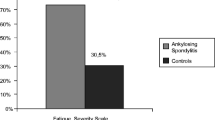Abstract
This study was designed to evaluate (a) the frequency of fatigue and its multi-dimensional nature, and (b) its association with demographic variables, disease-specific variables, and other variables, covering depression and sleep disturbance in patients with ankylosing spondylitis (AS). Sixty-two patients with AS were included in the study. Fatigue was assessed by the fatigue item of the Bath Ankylosing Spondylitis Disease Activity Index (BASDAI) and the Multidimensional Fatigue Symptom Inventory—Short Form (MFSI-SF). While the disease activity was evaluated by the BASDAI, the functional state was assessed by Bath Ankylosing Spondylitis Functional Index, metrological measurements by Bath Ankylosing Spondylitis Metrology Index, global well-being by Bath Ankylosing Spondylitis Global Score, the pain on rest by VAS (0–10 cm), sleep disturbance by Pittsburgh Sleep Quality Index, and depressive symptoms by Zung Self-Rating Depression Scale. Fifty percent of the patients had severe fatigue. Multi-dimensional assessment with MFSI-SF enabled us to identify fatigue in more detail. The disease-specific variables, covering pain, stiffness, disease activity, and physical functioning, contributed significantly with both BASDAI fatigue and MFSI-SF as dependent variables, accounting for 61.3% and 44.7% of the variance, respectively. Disease activity was the most powerful predictor of both single-dimensioned and multi-dimensioned fatigue. It was also found that the contribution of depression on fatigue was 12%. In conclusion, it was observed that half of the patients had severe fatigue, and multi-dimensional assessment was provided to understand specific aspects of fatigue better. Even though disease activity had a considerable effect on fatigue, the effects of psychogenic factors, especially depression, should be taken into consideration in the management of AS.
Similar content being viewed by others
References
Swain MG (2000) Fatigue in chronic disease. Clin Sci 99:1–8
Belza B (1994) The impact of fatigue on exercise performance. Arthritis Care Res 7:176–180
Dagfinrud H, Vollestad NK, Loge JH, Kvien TK, Mengshoel AM (2005) Fatigue in patients with ankylosing spondylitis: a comparison with the general population and associations with clinical and self-reported measures. Arthritis Rheum 53:5–11
Missaoui B, Revel M (2006) Fatigue in ankylosing spondylitis. Ann Readapt Med Phys 49:389–391
Zochling J, Braun J (2007) Assessments in ankylosing spondylitis. Best Pract Res Clin Rheumatol 21:699–712
van Tubergen A, Coenen J, Landewé R, Spoorenberg A, Chorus A, Boonen A, van der Linden S, van der Heijde D (2002) Assessment of fatigue in patients with ankylosing spondylitis: a psychometric analysis. Arthritis Rheum 47:8–16
Calin A, Edmunds L, Kennedy LG (1993) Fatigue in ankylosing spondylitis—why is it ignored? J Rheumatol 20:991–995
Jones SD, Koh WH, Steiner A, Garrett SL, Calin A (1996) Fatigue in ankylosing spondylitis: its prevalence and relationship to disease activity, sleep, and other factors. J Rheumatol 23:487–490
Dernis-Labous E, Messow M, Dougados M (2003) Assessment of fatigue in the management of patients with ankylosing spondylitis. Rheumatology 42:1523–1528
van der Linden S, Valkenburg HA, Cats A (1984) Evaluation of diagnostic criteria for ankylosing spondylitis. A proposal for modification of the New York criteria. Arthritis Rheum 27:361–368
Akkoc Y, Karatepe AG, Akar S, Kirazli Y, Akkoc N (2005) A Turkish version of the bath ankylosing spondylitis disease activity index: reliability and validity. Rheumatol Int 25:280–284
Karatepe AG, Akkoc Y, Akar S, Kirazli Y, Akkoc N (2005) The Turkish versions of the bath ankylosing spondylitis and dougados functional indices: reliability and validity. Rheumatol Int 25:612–618
Jenkinson TR, Mallorie PA, Whitelock HC, Kennedy LG, Garrett SL, Calin A (1994) Defining spinal mobility in ankylosing spondylitis (AS). The Bath AS Metrology Index. J Rheumatol 21:1694–1698
Jones SD, Steiner A, Garrett SL, Calin A (1996) The Bath Ankylosing Spondylitis Patient Global Score (BAS-G). Br J Rheumatol 35:66–71
Stein KD, Jacobsen PB, Blanchard CM, Thors C (2004) Further validation of the multidimensional fatigue symptom inventory—short form. J Pain Symptom Manage 27:14–23
Da Costa D, Dritsa M, Ring A et al (2004) Mental health status and leisure-time physical activity contribute to fatigue intensity in patients with spondylarthropathy. Arthritis Rheum 51:1004–1008
Buysse DJ, Reynolds CF, Monk TH, Berman SR, Kupfer DJ (1989) The Pittsburgh Sleep Quality Index: a new instrument for psychiatric practice and research. Psychiatry Res 28:193–213
Zung WWK (1965) A self-rating depression scale. Arch Gen Psychiatry 12:63–70
Smets EM, Garssen B, Bonke B, De Haes JC (1995) The Multidimensional Fatigue Inventory (MFI) psychometric qualities of an instrument to assess fatigue. J Psychosom Res 39:315–325
Turan Y, Duruöz MT, Bal S, Guvenc A, Cerrahoglu L, Gurgan A (2007) Assessment of fatigue in patients with ankylosing spondylitis. Rheumatol Int 27:847–852
Ward MM (1999) Health-related quality of life in ankylosing spondylitis: a survey of 175 patients. Arthritis Care Res 12:247–255
Mengshoel AM, Forre O (1993) Pain and fatigue in patients with rheumatoid disorders. Clin Rheumatol 12:515–522
Bakker C, van der Linden S, van Santen-Hoeufft M, Bolwijn P, Hidding A (1995) Problem elicitation to assess patient priorities in ankylosing spondylitis and fibromyalgia. J Rheumatol 22:1304–1310
Barlow JH, Macey SJ, Struthers GR (1993) Gender, depression, and ankylosing spondylitis. Arthritis Care Res 6:45–51
Disclosures
None.
Author information
Authors and Affiliations
Corresponding author
Rights and permissions
About this article
Cite this article
Günaydin, R., Göksel Karatepe, A., Çeşmeli, N. et al. Fatigue in patients with ankylosing spondylitis: relationships with disease-specific variables, depression, and sleep disturbance. Clin Rheumatol 28, 1045–1051 (2009). https://doi.org/10.1007/s10067-009-1204-1
Received:
Revised:
Accepted:
Published:
Issue Date:
DOI: https://doi.org/10.1007/s10067-009-1204-1



